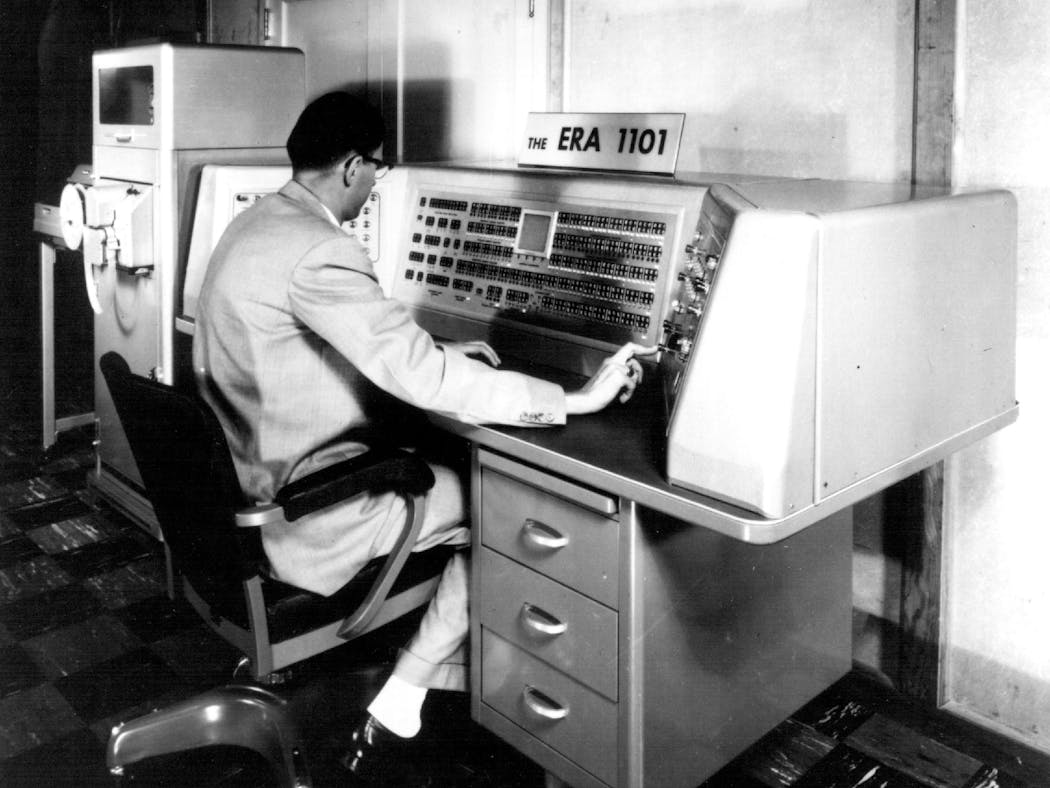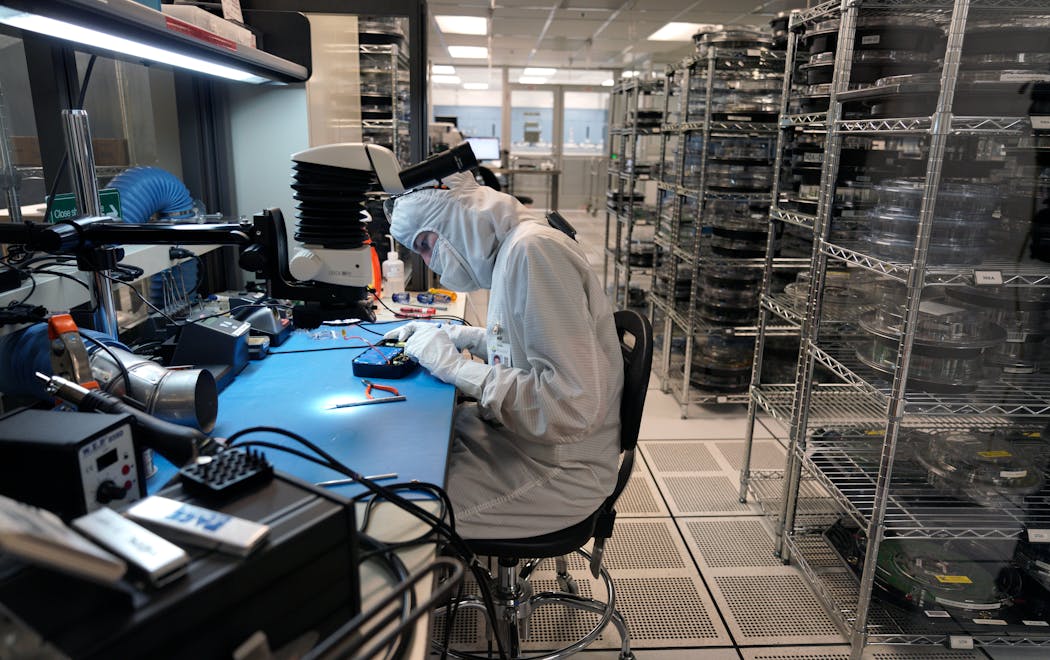Minnesota companies once dominated the supercomputer industry. What happened?
Listen and subscribe to our podcast: Via Apple Podcasts | Spotify | Stitcher
A half-century ago, Minnesota was home to companies that built the fastest and most complex computers in the world.
Minnesota-based Control Data, Univac and Cray Research dominated the field of supercomputers, the pinnacle of high-tech engineering.
Ted Adams wondered why the Twin Cities lost its position as a major force in the computer industry. He sought answers from Curious Minnesota, the Star Tribune's community reporting project fueled by reader questions.
In 1967, Adams finished a master's program in electrical engineering at the University of Minnesota with a thesis about an algorithm to speed up processing in computers. He took a medical technology job in Milwaukee and then returned to the Twin Cities to work at Medtronic in 1977.
By that time, however, Control Data, Univac and Cray were near or past their peak.
"I still wonder how three big industry leaders could all fail while the market for computers was growing all around the world," Adams said.
The short answer is that Minnesota's tech giants either didn't understand — or lacked the financial incentive to embrace — the invention of the microprocessor, which happened in the early 1970s and made smaller computing devices possible.
Post-war code-breaking
Minnesota's start in computers came at the end of World War II, when businessman John E. Parker looked for something new to do with his factory in St. Paul that built gliders for the Army Air Force. Three veterans approached Parker seeking space to build primitive computing-type devices that the military could use to break codes.
Parker and some other investors agreed to set up a company for the vets. They called it Engineering Research Associates.
"ERA created new computing machines, including one called Demon to crack one of the Soviet Union's codes," Lee Schafer, the Star Tribune's recently-retired business columnist, wrote in 2017. "The Soviets simply changed their code, and that pretty much ended the era of ERA's special-purpose machines, but it went on to create programmable ones."
In just a few years, though, Parker found it difficult to keep up with the money that rival IBM was pouring into its computer division. He sold ERA in 1952 to Remington-Rand Inc. after meeting its chairman, the just-retired Army general Douglas MacArthur. ERA got a rebrand: Univac.
In 1957, William Norris, who had been one of ERA's early employees, feared his career was coming to a dead end inside Univac. With some colleagues, Norris started a new firm called Control Data, which would become the biggest of scores of spinoffs with roots in ERA. At its peak, Control Data employed 25,000 in Minnesota and Wisconsin.
One of those colleagues, Seymour Cray, became the principal designer of Control Data's biggest computers. In 1972, he left Control Data to start Cray Research.
At the time, IBM dominated the computer industry with mainframes aimed at business. But Minnesota's companies produced the first supercomputers, built with far more electrical circuitry for the most difficult computing tasks.
'Dominated supercomputing'
"From Control Data in 1964 through the Cray 2 [in 1985], Minnesota companies controlled that whole category," said Thomas Misa, a retired U of M professor and author of "Digital State," a book on the state's high-tech history. "They just dominated supercomputing. Those were the fastest computers in the world."
For example, supercomputers were used for nuclear research, tracking weather patterns and helping energy companies decide where to drill.
"Prior to all this, Minnesota was primarily an agriculture, mining and timber state. The electronics companies brought a whole new character to Minnesota," said Donald Hall, who worked at Control Data before becoming a stockbroker. Hall wrote a 2014 history of Control Data, "Generation of Wealth," and is now leading an effort to install a historical marker at the original ERA plant at 1902 Minnehaha Ave. in St. Paul.
Hall argues in his book that the state's early foray into high-tech laid the groundwork for the medical device makers and startups on the contemporary Twin Cities business scene.
Misa, who led the tech history office at the U called the Charles Babbage Institute, notes that Parker and Norris and others in mid-century Minnesota relied on mechanical, managerial and financial expertise from industries that preceded them.
"In the earlier part of the century, Minnesota had a huge railroad industry, agro-processing industry, all kinds of businesses that were important for the time," Misa said. "You don't just get a tech industry built from nowhere."
But those giants of the 1970s fell victim to what's now widely called disruptive innovation, a concept popularized by the late Harvard professor Clayton Christensen. It's what happens when a product starts out at the bottom of an existing marketplace and eventually moves up in value to replace the established competitors.
Overtaken by innovation
The makers of supercomputers and mainframes, even IBM, were originally dismissive when a then-small maker of memory chips called Intel Corp. built a "computer-on-a-chip" for a Japanese adding-machine company.
The processing in mainframe and supercomputers happened in actual electrical circuits — wires strung across boards in patterns resembling quilts. They took up a lot of space and were built into cabinets that, in some cases, filled rooms.
Intel's invention became known as the microprocessor. It was first used in digital watches and calculators, but it became far more important with the arrival of the personal computer later in the 1970s.
After the microprocessor changed the value equation for computers, PC makers like Dell, Compaq and Apple became far larger than Control Data or Cray. Profit power shifted to Intel and the company that made the basic operating software for PCs, Microsoft. They dominated computing until the rise of smartphones in the late 2000s.
The Minnesota computer powerhouses "didn't want to get into personal computers because it would have threatened their pricing structure," said Steve Alexander, the retired Star Tribune reporter who covered their demise in the 1990s and early 2000s.
Parts of Control Data live on. Its chip factories are up and running in Bloomington, bigger than ever, under new owners — Polar Semiconductor and SkyWater Technology. Its disk drive factory in Bloomington is a unit of Seagate. And its biggest surviving business, Ceridian HCM Holding, which descended from a software unit, is just across the street from Control Data's former headquarters near the Mall of America.
Univac became part of Unisys, then Lockheed-Martin, which closed the last Minnesota remnants of Univac in 2012. And the last of several companies that bore Cray's name was purchased by Hewlett Packard Enterprise three years ago.
If you'd like to submit a Curious Minnesota question, fill out the form below:
Read more Curious Minnesota stories:
Why do so many Fortune 500 companies call Minnesota home?
Was Minnesota home to nuclear missiles during the Cold War?
Did Ford make millions of windows from sand mined beneath its plant?
From bankrupt racetrack to aviation hub — what remains from MSP Airport's early days?
Where does Twin Cities electricity come from and how is it delivered to homes?
Why did Minneapolis' famous flour boom go bust?








